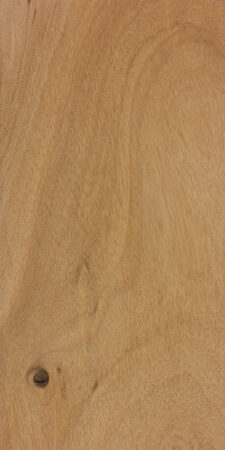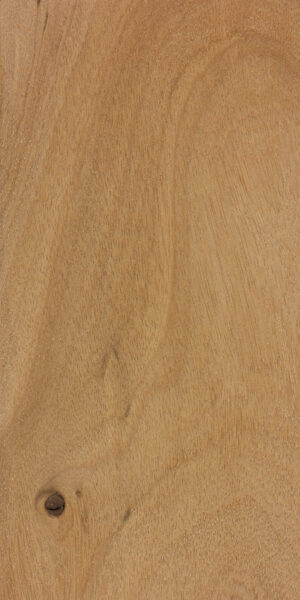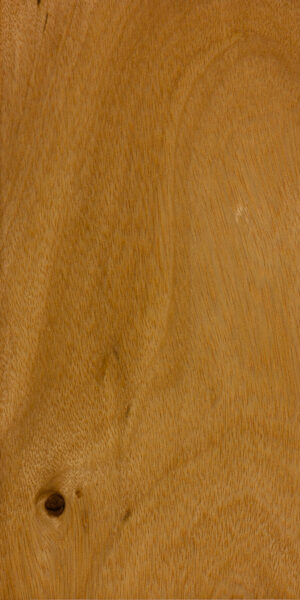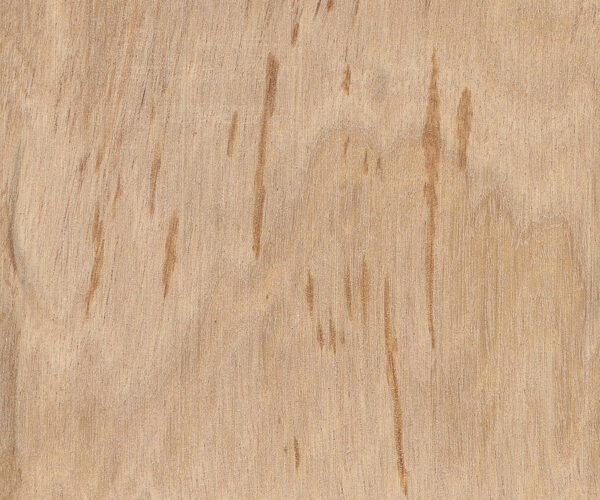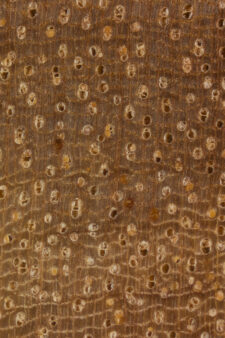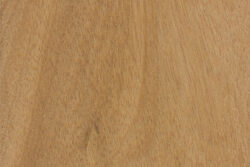Common Name(s): Bekak, amoora, aglaia
Scientific Name: Aglaia lawii
Distribution: Southeast Asia and Pacific Islands
Tree Size: 100-130 ft (30-40 m) tall,
5-7 ft (1.5-2.0 m) trunk diameter
Average Dried Weight: 47.8 lbs/ft3 (765 kg/m3)
Specific Gravity (Basic, 12% MC): .64, .77
Janka Hardness: 1,600 lbf (7,120 N)
Modulus of Rupture: 21,020 lbf/in2 (145.0 MPa)
Elastic Modulus: 2,287,000 lbf/in2 (15.77 GPa)
Crushing Strength: No data available
Shrinkage: Radial: 5.0%, Tangential: 8.4%,
Volumetric: 13.6%, T/R Ratio: 1.7
Color/Appearance: Can range in color from a pale brown to a darker reddish brown. Frequently color is linked to density—heavier pieces tend to be darker in color. Overall appearance resembles mahogany.
Grain/Texture: Grain is usually interlocked, and quartersawn surfaces can exhibit a ribbon-stripe grain pattern. Has a fine, even texture and moderate natural luster.
Rot Resistance: Varies depending on particular Aglaia species and growing conditions of the tree, but is generally considered moderately durable to durable.
Workability: Easy to work with hand and machine tools. Turns, glues, stains, and finishes well. Has a tendency to warp or deform during initial drying, although dimensional stability is good once dry.
Odor: Has a pleasant, lingering odor that’s been compared to both cedar and camphor (Cinnamomum camphora).
Allergies/Toxicity: Although severe reactions are quite uncommon, wood in the Aglaia genus has been reported to cause skin and respiratory irritation. See the articles Wood Allergies and Toxicity and Wood Dust Safety for more information.
Pricing/Availability: Not commonly exported, availability is most likely limited to locally harvested trees within its natural range. Expect prices to be in the mid range for a domestic hardwood.
Sustainability: This wood species is not listed in the CITES Appendices, and is reported by the IUCN as being a species of least concern.
Common Uses: Interior construction, furniture, cabinetry, veneer, boatbuilding, gunstocks, tool handles and other turned objects.
Comments: Aglaia is a fairly large genus with a wide divergence of woods with different densities. Many species used to be classified in the Amoora genus (and this is one of the common names for this wood). Wood species are commonly grouped together and simply sold under their genus name, aglaia (or amoora).
Being in the Meliaceae (mahogany) family, bekak can be thought of as almost a cross between two more well-known Meliaceae spceies: Honduran mahogany (Swietenia macrophylla) and Spanish cedar (Cedrela odorata). Visually, it resembles genuine mahgany (though perhaps lacking a bit of its color contrasts), but it also has a lingering scent that’s been compared to cedar.
Images: Drag the slider up/down to toggle between raw and finished wood.
There are currently no pictures of this exact wood species, but a similar species within the Aglaia genus is being substituted (A. spectabilis). If you’d like to contribute a wood sample for this webpage, please see the contact form for donating wood samples.
Identification: See the article on Hardwood Anatomy for definitions of endgrain features.
Porosity: diffuse porous
Arrangement: solitary and radial multiples
Vessels: large to very large; very few; whitish and yellowish deposits common
Parenchyma: diffuse-in-aggregates, banded
Rays: narrow, normal spacing
Lookalikes/Substitutes: Bekak bears a resemblance to genuine mahogany (Swietenia macrophylla) and is actually botanically related—both woods being in the Meliaceae family. Aglaia species can be separated from most mahoganies based on its fragrant heartwood scent and banded (never marginal) parenchyma.
Notes: The endgrain of a related species, Aglaia spectabilis is pictured. There may be slight discrepancies in endgrain anatomy between A. spectabilis and A. lawii.
Related Content:

